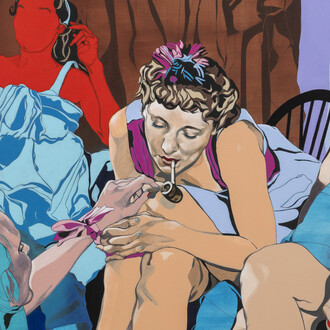This autumn, Eye Filmmuseum spotlights American avant-garde cinema of the 1960s. The exhibition and extensive accompanying programme feature screenings of both iconic and lesser-known films, highlighting the explosion of formal experimentation in artistic filmmaking of the period. On show are works by key figures of avantgarde cinema, including Jonas Mekas, Marie Menken and Stan Brakhage, and by makers from the art world, among them Bruce Conner, Yayoi Kusama, Yoko Ono and Andy Warhol. All of this is set against the background of a changing society.
Dancing bridges, introspective diary fragments and dreamy stop motions – just some examples of experiments carried out by a loose collection of avant-garde filmmakers in the 1960s in the United States. Their aim: to shake off the shackles of Hollywood and the dominant film industry and create a breeding ground for filmmakers in search of freedom and experimentation. In the exhibition Underground: American avant-garde film in the 1960s, Eye adds a new chapter to its long tradition of giving avant-garde and experimental film a prominent place, both in its collection and programming. After all, the Filmliga was the film museum's founding collection.
In Underground, Eye shows how filmmakers are discovering the medium to make art and express themselves, engaging in cross-disciplinary film experiments: from independent, unconventional films for cinemas, some self-operated, to expanded experiments such as Andy Warhol’s eight-hour Empire (1964) or Stan VanDerBeek’s imposing 11-channel installation Movie mural (1965-1968). The latter to be screened in the Netherlands for the first time.
The colour of blood
Filmmaker Jonas Mekas, spokesperson for the New American Cinema Group, captures the essence of this wave of filmmakers with one succinct statement. “We don’t want false, polished, slick films – we prefer them rough, unpolished, but alive; we don’t want rosy films: we want them the color of blood”. The example they set and manifesto they recorded, exerted a profound and lasting influence on successive generations of filmmakers in the US and beyond. The exhibition zooms in on the source of this underground movement, tracing the emergence of experimental cinema in America and the formation of collectives that were active from the early 1960s, among them the New American Cinema Group and the FilmMakers’ Cooperative in New York, Fluxus and Canyon Cinema in San Francisco.
Scratches, double exposure and multiple screens
The underground filmmakers wanted to break the limiting and conservative rules of mainstream cinema. They liberated themselves from commercial production and distribution companies, creating their own breeding ground for filmmakers who were searching for freedom and experiment. They explored the intersection of film, dance, photography, poetry, literature and visual art, challenging the medium in all sorts of ways. Film strips were scratched, films were double exposed and presented on multiple screens placed beside one another, and so on.
The social unrest of the 1960s also echoed in many films. For example, Carolee Schneemann’s Viet-Flakes (1965) presents an alternative view of the horrific reality of the Vietnam War, Bruce Conner offers a damning criticism of consumerism on the basis of new reports of the assassination of JFK, and Storm De Hirsch examines optical illusion and spirituality in Third eye butterfly (1968).
Underground presents works by Bruce Baillie, Stan Brakhage, Maya Deren, Shirley Clarke, Bruce Conner, Storm De Hirsch, Jonas Mekas, Yayoi Kusama, Marie Menken, Gunvor Nelson, Yoko Ono, Carolee Schneemann, Stan VanDerBeek, Hollis Frampton en Andy Warhol. Blow-ups and physical and original material from the period, such as invitations, posters, photographs, personal notes and brochures, conjure up the mood of the times. The exhibition is curated by Jaap Guldemond, Director of Exhibitions, and Mark Paul Meyer, senior curator of the Eye collection.
Films, talks and events
The exhibition continues in the Eye cinemas, where the best-known and longer 16mm films by leading makers from the underground scene will be screened in full. The programmes also look at the international context, assess the lasting impact and influence of New American Cinema outside the United States, and examine the situation today. On election night in America (5 November 2024), various speakers will discuss how the underground scene of the 1960s highlighted political issues and how that is reflected in the current political climate.
The programme shines a special spotlight on psychedelic film – an important theme in 1960s America, which is undergoing a revival today. Moreover, psychedelics are inextricably linked with the ‘liberal’ character of Amsterdam. In cooperation with the University of Amsterdam.
















